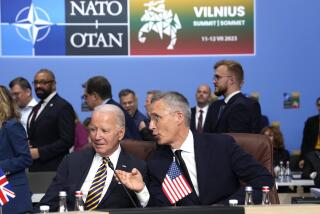Soldier’s Tales : Three Veterans Remember D-Day
- Share via
They’re all in their 70s now. Some would call them heros. Their stories are very personal but they do belong to history, the legacy of what they did for their country in places with names like Sainte-Mere-Eglise, Bayeux, Carentan and Arromanches. On June 6, 1944, they landed on beaches code-named Utah, Omaha, Gold, Juno, and Sword. They were boys, then, in their 20s, and they help liberate Europe from Nazi tyranny. Officially, it was called D-Day, the day of decision to send 5,300 ships, 155,000 soldiers and 12,000 aircraft on an assault of a fortified French coastline of Normandy. It was the largest invasion in history, and turned the tide against the Nazis.
Here are snapshots of three veterans from that conflict, Frank Corrales, Jack Stephenson and Andy Draghi. Stephenson revisited Normandy last year, and Draghi is going to Normandy in June to celebrate the anniversary. But Corrales will never go back.
*Frank Corrales, Encino “And then it went beyond fear. . .”
Corrales was in the Big Red One, the combat unit immortalized and, Corrales thinks, romanticized by Hollywood. Corrales was in the second wave of troops that landed on D-Day. He was 26 years old.
“We left Portsmouth (England) the day before at the crack of dawn. It was a rough crossing. We couldn’t find shallow water to land the troops. I was up to my neck in water. There were bodies all over the place. It felt like a dream. Like watching a movie.
On shore shells were hitting all around us. We were all scared. And then it went beyond fear. I never want to go back. It’s a very, very bad memory for me. I don’t want to see it again. There were no John Waynes. No gung-ho guys. Just a bunch of human beings. Had we had our choice we never would have gone.”
Jack Stephenson, Studio City Stephenson has chosen to keep his D-Day memories alive. He’s met with his buddies from the 3rd Armored Spearhead Division every year since 1948. Stephenson talks about the war with the clarity of a professor of history. He was a newspaper pressman in the 1940s so he got to see his name in the paper before he received the famous “greetings” letter. It was 1942. He was 21. He went overseas two years later.
“The Big Red One, the 29th Infantry Division and the 4th Infantry Division got the beaches clear. A storm came up and we were delayed for three days waiting for the weather to change. We didn’t know what was going to happen. Never been in combat before. We were all draftees. We just went about our jobs and stayed alert, dug in so we had a place to dive into when shells came in. The dead were lieing in fields. No one had time to pick them up. You get used to that.
“The first battle we fought we broke through the German lines like it was a football game. We were guards and tackles and (Gen. George) Patton came shooting through the middle with the 3rd Army. We still get so mad when the 3rd Army is mentioned. We hated Patton’s guts. He got credit for everything we did. We were the first to reach Belgium. The first to cross the German border. The first to capture German tanks. The first to shoot down German planes. The first to invade Germany since Napoleon. Patton got all the credit.”
*Anniversary Ceremonies
Beginning on June 5, President Clinton will join Queen Elizabeth 11, French President Francois Mitterand, and former presidents Ford, Carter, Reagan and Bush for the historic commemoration. Commemorative events will include re-enactment of the paratrooper drop by the 82d Airborne Division on Sainte-Mere-Eglise. There will also be a ceremony at Utah Beach, where the bulk of American forces landed.
Andy Draghi, Chatsworth
One of the best-kept secrets of the D-Day invasion was Mulberry, the operation to build two prefabricated harbors and breakwaters so troops and supplies could be delivered in sheltered waters to support the invasion. That task was left to the Merchant Marine. Draghi was part of that operation. He was a radio officer on the Liberty Ship S.S. Matt W. Ransom. Draghi is going back to Normandy this yea.
“On the morning of June 6 we knew we were due to go. We watched as the warships started out on their mission. Slowly we moved out. There were so many ships. All morning and into the evening bomber and fighter planes were headed for France -- literally layers of them. Their wings and fuselages were painted with white and black stripes. Heavy gun firing was heard. Flashes were lighting up the sky. It was almost midnight. I was looking at the wreckage of a Navy fighter that had crashed. Suddenly a body appeared . . . and it banged against the hull. It was headless. Everyone became silent. The war was real.”
Researched by LINDA FELDMAN / For The Times; Current photos by DAVID BOHRER / For The Times
More to Read
Sign up for Essential California
The most important California stories and recommendations in your inbox every morning.
You may occasionally receive promotional content from the Los Angeles Times.













